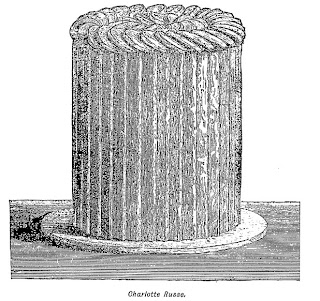I work part time as an educator at the Lower East Side Tenement Museum(Wednesday and Saturday if you ever want to stop by and see a tour). While studying information for a new tour, I came across a mention of “Charlotte Russe.” Charlotte Russe, it said, was sold from pushcarts on the streets of the Lower East Side in the 1920s. “What the hell’s Charlotte Russe?” I wondered.
Charlotte Russe, in it’s simplest form, is whipped cream adorned with lady fingers. The fanciest version I’ve seen involves mace-flavored whipped cream, mixed with isinglass, and pressed into a mold lined with almond sponge cake. Sounds pretty good, right? I plan to give this latter recipe a whirl in the near future.
Charlotte Russe
1. Line a mold with the ladyfinger cookies. A medium-sized bowl works just fine.
3. Dissolve gelatin in cold water. Heat milk in a microwave for two minutes on high, then add to gelatin. Add sugar and vanilla, whisk until sugar is dissolved.
4. Set in a pan of ice water, stirring constantly until the mixture just begins to thicken. Or, you can place the mixture in the freezer, stirring every minute. But be careful! If the mixture gels too long, you’ll end of with tapioca-like lumps in the final product.
5. Beat with an electric mixer on high for five minutes; then add in 1/3 of the whip cream and mix until thoroughly combined. Gently fold in the remaining whip cream with a spatula until just combined.
I served this at a dinner party and we all agreed it was tasty, but a little plain. It was like inside-out angel food cake. I think although it was a little boring for our modern day pallets, it probably would have tasted like heaven to a kid on the streets in the 1920s.
Update: After a little poking around on the internet, I found a few descriptions of what Charlotte Russe would have looked like in New York. I has assumed it was a simple version, just whipped cream and lady fingers, but it was held in a cardboard contraption that made it easy to eat on the go. From The Food Timeline:
“Charlotte russe. A French dessert (supposedly created by Marie-Antonin Careme) made in mold with ladyfingers and Bavarian cream…While this confection is known and made in the United States, a simple version consisting of a square of sponge cake topped with whipped cream (sometimes with chocolate sprinkles) and a maraschino cherry was also called a “charlotte russe”…This was a standard item in eastern cities, particularly among urban Jewish Americans (some of whom pronounce the item “charely roose” or “charlotte roosh”), who made it at home or bought it at a pastry shop, where it was set on a frilled cardboard holder whose center would be pushed up as to reveal more cake as the whipped cream was consumed.”
—Encyclopedia of American Food and Drink, John F. Mariani [Lebhar-Friedman:New York] 1999
“…But to old-time Brooklynites, a charlotte russe was a round of sponge cake topped with sweetened whipped cream, chocolate sprinkles, and sometimes a marashcino cherry, surrounded by a frilled cardboard holder with a round of cardboard on the bottom. As the cream went down, you pushed the cardboard up from the bottom, so you could eat the cake…these were Brooklyn ambrosia.”
—The Brooklyn Cookbook, Lyn Stallworth and Rod Kennedy, Jr. [Alfred A. Knopf:New York] 1994 (p. 386)




Autumn announced its arrival in my Bronx neighborhood when the candy stores
displayed their Charlotte Russe product in window boxes adjacent to a sliding
window pane adjacent to the store’s soda fountain. Whipped cream requires refrigeratio and back then (1930-40’s) no one owned anything resembling a refrigerated outdoor display case. By late September the weather was usually cool enough to naturally keep this delicious treat preserved.
I never thought of them being seasonal!! How interesting!